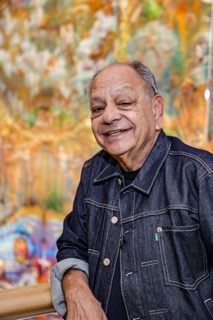Entertainer Richard “Cheech” Marin may be known for his mischievous jokes and broad sense of humor, but he’s serious about his art collection. Marin, who gained fame in the 1970s as part of the “Cheech and Chong” comedy duo, is also recognized for developing the most extensive private collection of Chicano art in the United States, featuring around 1,000 artworks. Marin started collecting in the 1980s, noticing that Chicano art was not widely represented in museums or galleries.
Art historians didn’t take the work seriously, he says, often considering it folk art unworthy of respect. Those attitudes are changing. After touring his collection across the country for several years, he’ll be putting a wide array of works on display in Riverside beginning June 18 with “Cheech Collects,” the year-long exhibition launching The Cheech Marin Center for Chicano Art & Culture. Art installation began in April with the arrival of a mesmerizing piece by Einar and Jamex de la Torre that greets visitors as they enter. Inspired by Aztec goddess Coatlicue, the work was specifically commissioned for the museum entrance, and shows the goddess rising from the earth.
As observers move sideways in front of the LED-backlit image, it shifts to suggest a robot made from lowrider cars, with a background map featuring solar panels and windmills. The lenticular process used to make the artwork creates optical illusions that provide a sensation of movement. Jamex de la Torre says the goddess is “beckoning us back to a simpler life, using less resources and eventually living in harmony with nature. We see technology as the only way out of the global warming debacle.” Different levels of the intricate 26-foot-tall art piece reveal more aspects of the goddess and her connection to Southern California, with its cities and free- ways as well as flora and fauna.
There’s even a small image of Marin himself in the lower left-hand corner, next to an angel. How did Marin decide to create an Inland Empire art des- tination? “I wanted to be in a city and a region with a large Spanish-speaking heritage community,” he says. “We hope to serve the artistic spirit of the people of the Inland Empire and bring every aspect of Chicano art to Riverside and the rest of the world. We have something wonderful to give.” After a 2017 exhibition at the Riverside Art Museum from Marin’s collection drew record crowds, museum and city officials began working on a plan to bring more of his art to the city.
Other institutions had shown little interest in showcasing the collection, says Marin, now 75, and he was reaching a stage in life where he needed to figure out a future home for his paintings. That home turned out to be Riverside’s former Main Library, a 1965 edifice in the “New Formalism” style. City officials had been struggling for years to figure out what to do with the imposing structure, which they said was no longer well suited for library use, while occupying a prominent place downtown. An agreement was reached for the city to hire Riverside Art Museum to manage the new center, which would be financed by a variety of public and private funds. Marin expressed a hope the museum would be referred to simply by his nickname, and it’s now known informally as “The Cheech.”
But as Marin quipped soon after the initial announcement, he didn’t realize that when Riverside offered to give him a museum he would have to spend the rest of his life fundraising. “There’s noth- ing so expensive as a free gift!” he says with a grin. He’s been dedi- cating considerable energy to appearing at events and is pleased with the strong support the center is receiving from the region. The center’s educational mission is also important to him, as he seeks to gain wider recognition for the artists he’s come to appreci- ate over the years, including Patssi Valdez and Frank Romero. “I recognized right away that these artists were special. In the beginning, Chicano art was political art. Chicano art is a combination of traditional Mexican art and contemporary world art.
It is an evolutionary form that keeps mutating while still maintaining a Latino element. It is the first truly American school of art in almost 70 years.” His collection represents a myriad of techniques, from watercolor and aquatint to pastel and mixed media, from the 1980s to the pres- ent. Works display iconic imagery, with influences ranging from pre-Hispanic symbols and post-revolutionary nationalistic Mexican motifs to the Chicano movement of the 1960s and contemporary urban culture. Sculpture and photography are also included. Artistic director Maria Esther Fernandez is especially interested in promoting research opportunities with local universities as she seeks to increase understanding about The Cheech’s art collection. She also wants to encourage aspiring artists with educational opportunities at the center. While its exterior remains largely unchanged, the interior has been substantially renovated. The former Children’s Room on the second floor is now the educational center. Longtime library patrons will recognize the staircase’s wood and aluminum balustrade, and the second-floor auditorium.
The entrance lobby expresses the concept of a zocalo, or town square, that connects the four main galleries and also has a gift shop; a café may be added later. Marin his wife, Natasha, have a place in Joshua Tree as well as their home in Pacific Palisades, so Riverside is a great place to stop in between those two locales, he says. He likes to stay at the Mission Inn hotel, and plans to be taking part in museum events as he shares his collection with the public. That collection continues to grow. “It’s an addiction,” Marin says with a smile, acknowledging he can’t stop acquiring new pieces. “There’s so much great work by so many great artists.”


